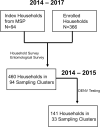Exploring the utility of social-ecological and entomological risk factors for dengue infection as surveillance indicators in the dengue hyper-endemic city of Machala, Ecuador
- PMID: 33740003
- PMCID: PMC8011822
- DOI: 10.1371/journal.pntd.0009257
Exploring the utility of social-ecological and entomological risk factors for dengue infection as surveillance indicators in the dengue hyper-endemic city of Machala, Ecuador
Abstract
The management of mosquito-borne diseases is a challenge in southern coastal Ecuador, where dengue is hyper-endemic and co-circulates with other arboviral diseases. Prior work in the region has explored social-ecological factors, dengue case data, and entomological indices. In this study, we bring together entomological and epidemiological data to describe links between social-ecological factors associated with risk of dengue transmission at the household level in Machala, Ecuador. Households surveys were conducted from 2014-2017 to assess the presence of adult Aedes aegypti (collected via aspiration) and to enumerate housing conditions, demographics, and mosquito prevention behaviors. Household-level dengue infection status was determined by laboratory diagnostics in 2014-2015. Bivariate analyses and multivariate logistic regression models were used to identify social-ecological variables associated with household presence of female Ae. aegypti and household dengue infection status, respectively. Aedes aegypti presence was associated with interruptions in water service and weekly trash collection, and household air conditioning was protective against mosquito presence. Presence of female Ae. aegypti was not associated with household dengue infections. We identified shaded patios and head of household employment status as risk factors for household-level dengue infection, while window screening in good condition was identified as protective against dengue infection. These findings add to our understanding of the systems of mosquito-borne disease transmission in Machala, and in the larger region of southern Ecuador, aiding in the development of improved vector surveillance efforts, and targeted interventions.
Conflict of interest statement
The authors have declared that no competing interests exist.
Figures


Similar articles
-
Social-ecological factors and preventive actions decrease the risk of dengue infection at the household-level: Results from a prospective dengue surveillance study in Machala, Ecuador.PLoS Negl Trop Dis. 2017 Dec 18;11(12):e0006150. doi: 10.1371/journal.pntd.0006150. eCollection 2017 Dec. PLoS Negl Trop Dis. 2017. PMID: 29253873 Free PMC article.
-
Spatiotemporal clustering, climate periodicity, and social-ecological risk factors for dengue during an outbreak in Machala, Ecuador, in 2010.BMC Infect Dis. 2014 Nov 25;14:610. doi: 10.1186/s12879-014-0610-4. BMC Infect Dis. 2014. PMID: 25420543 Free PMC article.
-
Dengue vector dynamics (Aedes aegypti) influenced by climate and social factors in Ecuador: implications for targeted control.PLoS One. 2013 Nov 12;8(11):e78263. doi: 10.1371/journal.pone.0078263. eCollection 2013. PLoS One. 2013. PMID: 24324542 Free PMC article.
-
Vector dynamics and transmission of dengue virus: implications for dengue surveillance and prevention strategies: vector dynamics and dengue prevention.Curr Top Microbiol Immunol. 2010;338:115-28. doi: 10.1007/978-3-642-02215-9_9. Curr Top Microbiol Immunol. 2010. PMID: 19802582 Review.
-
Interventions against Aedes/dengue at the household level: a systematic review and meta-analysis.EBioMedicine. 2023 Jul;93:104660. doi: 10.1016/j.ebiom.2023.104660. Epub 2023 Jun 21. EBioMedicine. 2023. PMID: 37352828 Free PMC article.
Cited by
-
Household and climate factors influence Aedes aegypti presence in the arid city of Huaquillas, Ecuador.PLoS Negl Trop Dis. 2021 Nov 16;15(11):e0009931. doi: 10.1371/journal.pntd.0009931. eCollection 2021 Nov. PLoS Negl Trop Dis. 2021. PMID: 34784348 Free PMC article.
-
Seroprevalence, incidence estimates, and environmental risk factors for dengue, chikungunya, and Zika infection amongst children living in informal urban settlements in Indonesia and Fiji.Res Sq [Preprint]. 2024 Nov 13:rs.3.rs-5141509. doi: 10.21203/rs.3.rs-5141509/v1. Res Sq. 2024. Update in: BMC Infect Dis. 2025 Jan 13;25(1):51. doi: 10.1186/s12879-024-10315-1. PMID: 39606478 Free PMC article. Updated. Preprint.
-
Bridging landscape ecology and urban science to respond to the rising threat of mosquito-borne diseases.Nat Ecol Evol. 2022 Nov;6(11):1601-1616. doi: 10.1038/s41559-022-01876-y. Epub 2022 Oct 27. Nat Ecol Evol. 2022. PMID: 36303000 Review.
-
The Ecological, Biological, and Social Determinants of Dengue Epidemiology in Latin America and the Caribbean: A Scoping Review of the Literature.Ecohealth. 2025 Jun;22(2):203-221. doi: 10.1007/s10393-025-01706-0. Epub 2025 Mar 27. Ecohealth. 2025. PMID: 40148718 Free PMC article.
-
A review of risk factors at the human-animal-environmental interface of garbage dumps that are driving current and emerging zoonotic diseases.One Health. 2024 Oct 10;19:100915. doi: 10.1016/j.onehlt.2024.100915. eCollection 2024 Dec. One Health. 2024. PMID: 39468997 Free PMC article. Review.
References
-
- PAHO. Integrated management strategy for arboviral disease prevention and control in the Americas. Washington, D.C., U.S.A: Pan American Health Organization, Pan American Sanitary Bureau, Regional Office of the World Health Organization; 2020.
-
- Pan American Health Organization. Plan continental de ampliación e intensificación del combate al Aedes aegypti. Informe de un grupo de trabajo, Caracas, Venezuela. Washington DC: PAHO; 1997. Report No.: OPS/HCP/HCT/90/97.
-
- Special Programme for Research and Training in Tropical Diseases, World Health Organization, editors. Dengue: guidelines for diagnosis, treatment, prevention, and control. New ed. Geneva: TDR: World Health Organization; 2009.
-
- WHO. Questions and answers on dengue vaccines: efficacy and longer-term safety of CYD-TDV. World Health Organization; 2015.
MeSH terms
LinkOut - more resources
Full Text Sources
Other Literature Sources
Medical

